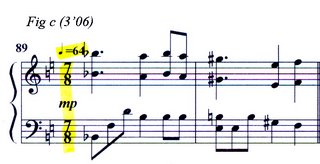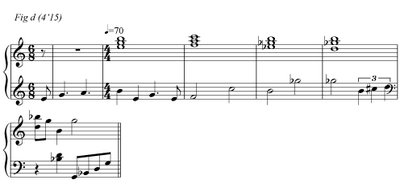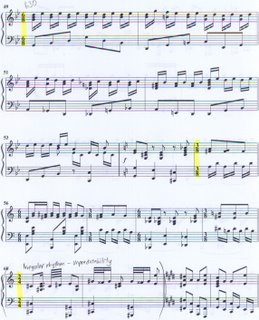hello.. thx for visiting this little blog that is primarily set up for my musical musings and thoughts. So do feel free to leave comments or just drop a note to say hi :D (so that this page won't seem so barren..)
Saturday, December 16, 2006
Big Day
Friday, December 15, 2006
Inspiration
Gotta start practicing new pieces for Diploma exam next year.. still contemplating whether to take nafa or nus one.. Oh and Qu lao shi said she hopes to hold a concert next year (if she can find sponsors) featuring all her students.. Wow great! another performance platform gained
2006 National Chinese Music Competition
Phew... Finally can enjoy my vacation!!! It has really been a busy semester for me
Sunday, December 10, 2006
YEAH
Friday, November 10, 2006
In Dreams - Harmonic, melodic analysis
An interesting point I observed is that most cadences in this piece occur from the strong to weak beat instead of the usual weak to strong beat, such as seen in bar 10 (plagal cadence), bar 12 (imperfect cadence) etc. This actually reduced the effect of cadential punctuation, injecting in the music a sense of continuous flow.
I also observed how the composer juxtaposes contrasting feelings in the same phrase.
In the main theme (see bars 9-12), the melodic idea felt calm and lyrical. Judging by the balanced and symmetrical melodic contour, a sense of closure is somehow felt. But the subtle usage of imperfect cadence (bar 12) injects a sense of incompleteness to this closure, spurring the music on as the tension for resolution is heightened.
Sometimes the embedded harmonic progressions also underline a certain melodic idea. For example in bar 17, the harmonic progression vi(6)–V(6/4)–vi(6/4) of D major [where its base notes are also D – E – F sharp] actually underlines or echoes the motif D – E – F sharp from the theme with rhythmic augmentation.
Another interesting aspect in bar 18-19, as seen in the bass progression, D–E–F sharp–E, underlying vi6-V(6/4)-vi(6/4)-V progression, the note ‘E’ has the tendency to resolve onto ‘D’ (chord I), but the composer proceed to a ‘G’ (chord IV) instead. Probably by prolonging this resolution to tonic, the music is equipped with some harmonic tension to portray the mood - that of restlessness above tranquility in the piece. It is also rare for chord V to precede chord IV, well at least not in the usual Classical music that we hear.
Fluidity in texture also contributed in giving the music a sense of continuous flow. This fluidity is in some way achieved by how one phrase relates to another. For instance in bar 25, phase overlapping occurs – where the closure of the first subject phrase is overlapped by the introduction of an agitated second subject.
Functional harmony


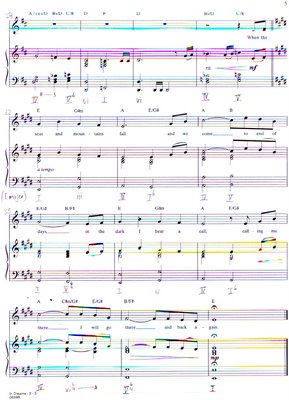
Monday, October 23, 2006
Prelude to “The Breaking of the Fellowship”
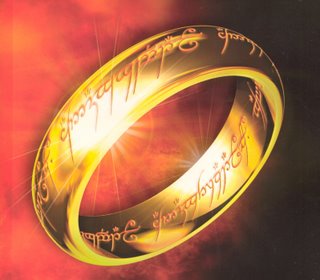
The Fellowship of the Ring, or Company of the Ring, as described in the first volume of The Lord of the Rings, is a union of 9 representatives from each of the free peoples (Dwarf, Elf, Hobbits, Men, Maia/Istar) in Middle-earth, the number chosen to match the 9 Ringwraiths.
The Fellowship is entrusted with the task of assisting and protecting Frodo Baggins as he bears the One Ring to the land of Mordor where he can destroy it by throwing it into Mount Doom. The 9 set out on their quest at the beginning of winter on December 25, 3018 T.A. after their Fellowship was formed at the Council of Elrond.
The fellowship is led at first by Gandalf, but after his fall in the mines of Moria, Aragorn leads them until Boromir's seduction by the ring coupled with the attack of the Orcs effects the breaking of the Fellowship.
ABOUT THE MUSIC (MACRO–VIEW)
Composer: Howard Shore
The music in general is lyrical and rich in ethnic and vocal fantasy.
I feel that Shores compositional approach to bring forth the action-packed scenes were more subdued and deep, unlike what one would usually find or hear in James Bond movies (which contains lots of percussion). Shores action music is deeply woven into a choral fabric with interweaving textures that provides the magical feel required in the storyline of ‘The Lord of the Rings', without the need to use prominent percussion writings to inject that excitement.
Orchestration, Texture and Contrast
To heighten the sense of importance and urgency in the music, Shore basically makes use of orchestration–such as large orchestral and choral ensembles, to achieve that dense and broad texture.
Sometimes the massive and gothic choral passages, so deeply dominated by the male singers, provide cues that are genuinely frightening, both religiously and otherwise. The dark and suspenseful music illustrate the temptation of the ring and the dangers lurking within the land of Middle–Earth, and the paranoia that are working in the hearts of some members of the Fellowship.
Bombastic and heroic choirs and music such as those found in “Treason of Isengard” reflect the sacrifices of brave men and the bravery of the members of the Fellowship despite being outnumbered by the forces of evil.
Lighter moments, through the use of staccatos found in the "Concerning Hobbits" cue, offer a break from the awe, thus providing stark contrasts within the music.
Of Motivic Idea
The main musical theme in any film plays a vital role in captivating audiences and listeners. In LOTR, the main theme is generally lyrical and heroic, aimed at the brass, but restrained by a unified and realized string section. In fact, after listening to the tracks from the trilogy, I discovered that the most effective and tender moments of this theme are performed by the weaving violins, cellos, and basses while the brass offer a soft accompaniment. Woodwinds are sometimes employed to inject the ethnic feel of a particular location into the music.
Tuesday, October 17, 2006
Audio Tracks are Up
To listen to them, please go to:
http://sg.geocities.com/yickjr/
For better quality listening, please save the files before playing them as the file size are quite large.
Wednesday, October 04, 2006
Albert Tiu and Thomas Hecht Duet Recital

As you might have guessed, I attended this concert yesterday and it was a truly wonderful experience. This was held in the new YST Concert Hall. For those who haven’t been there yet, it looks like a smaller version of the esplanade concert hall.
Ok, one thing I was really impressed on was the kaleidoscope of tonal shades/ colours surrounding me throughout their concert. I finally understood what it really means to have depth in one’s playing. The expressive range and sound scope produced was so huge, it was almost comparable to that of an orchestra.
Wow! It has been a long time since I had felt so alive with the sound of music. I feel so inspired, am going to practice piano as soon as I get home.
Sunday, October 01, 2006
'Jack and Sally Montage' - Harmonic Overview
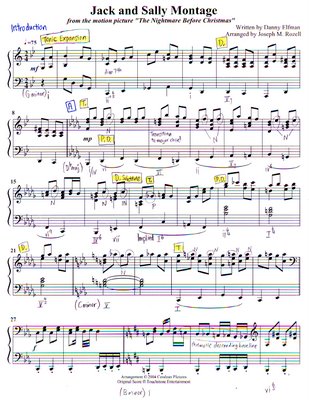

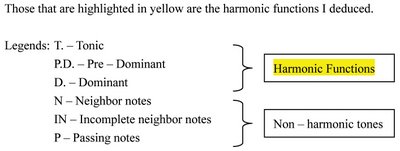
I found that a very prominent feature in one of its motivic idea is this semitonal movement (e.g. bar 9). This upper chromatic note may sometimes be treated as a neighbour note or part of the chord progression.
I felt that this piece of music can be largely classified as strophic form, but for easy reference I have labeled it according to the change in melodic / harmonic pattern and feel of music.
The outline of tonality is as follows:
Introduction: G minor
Section A: Db major → C minor → B minor (I just realized that these keys modulate in a chromatically descending manner!)
Transitory passage: seems to be in C major with lots of chromatically altered chords (although I can't quite notate it)
Section B: Bb major → G minor →Bb major
Transitory passage: C major (again with many chromatic embellishments)
Section C: E major (chord progression brought about by ascending whole tones, F #, G#, A#) → Bb major
Section B’: Bb major → G minor →Bb major
Transitory passage: C major
Section C’: G minor
Section D: A major → C major
Transitory passage: C major → Bb major
Section A’: G minor
Sunday, September 17, 2006
'Jack and Sally Montage' - Meter, Pulse Analysis II
Generally, although frequent changes in time signature occurs, listeners would still be able to feel the pulse/ beats of the music since regular rhythms such as semiquavers and quavers are used in abundance.
For instance, starting from bar 42, just by listening to the music without looking at the scores, listeners may first be deceived into thinking that the music has changed from 2/4 into 6/8 time due to the introduction of distinct dance/ waltz – like feel in the melodic and accompaniment pattern. However as one listens on, one senses the unevenness in pulse of the music (i.e. some bars have a beat more or less than 6/8).
Actual sequence of meter employed:
Starting from bar 42, the music passes through 7/8 (b.42-44), 5/8 (b.45), 6/8 (b.46-47), 7/8 (b.48), 6/8 (b.49-54) and then alternating each bar with 3/8 and 6/8 meter from bars 55-59.
As seen, the central time signature is 6/8, but the composer plays with our expectation by ingeniously adding or removing a quaver beat every few bars.
There are also instances, especially in linking passages where the sense of pulse becomes obscured to the listener. Such as in bars 89 – 90 (Fig c) and bars 116 beat 4 – 122 (Fig d) where the music seems to be suspended in time. This is achieved by rubato and the usage of longer valued notes coupled by changes in tempo.
Wednesday, September 06, 2006
'Jack and Sally Montage' - Rhythm & Pulse Analysis
Fig a

From bar 29 (or 0’43) onwards, the music seemed to intensify a little as a result of punctuation in the bass. From here onwards, the rhythmic pattern (shown in Fig b) which can be detected throughout the piece is first presented.
Fig b

The semiquavers in the 2nd beat seemed to propel the music forward. This rhythmic pattern is also a unifying feature which helps bind the entire work together.
From bar 42 onwards, the sense of beat/ pulse is not as clear as before because there are frequent changes in the time signature to irregular meters such as 7/8, 5/8, 3/8. This coupled with the use of more irregular rhythms such as seen in (bar 60, 126), changes in tempo and usage of firmata, gives the music a sense of unpredictability and unevenness which well matches the musical effect of eeriness and eccentricity portrayed by the animation.
Bars 42-48



Tuesday, September 05, 2006
About 'Jack and Sally Montage'
 This piece of music is taken from the motion picture "The Nightmare before Christmas".
This piece of music is taken from the motion picture "The Nightmare before Christmas".Composer: Danny Elfman

Synopsis:
One day, Jack discovers Christmas town - a land where everything is happy; nothing's dead. It seems to fascinate him and he decided to create Christmas for the world.
He had the Oggie Bboogie's Trick-or-Treaters go and get "Santa Claws" and now he is with the Oogie Boogie!
Jack trys to be the best Santa he can but it goes wrong and he gets shot down while making his present-giving rounds by the recipients of his version of Christmas.
Sunday, September 03, 2006
Sneak Preview
So here are some of my choices (subject to changes due to availability of scores):
'Jack and Sally Montage' from "The Nightmare Before Christmas",
'One Jump Ahead' from Disney's Aladdin,
One of the soundtracks from 'The Lord of the Rings',
Maybe another soundtrack from 'Harry Potter' ,
Or 'Hero' by Tan Dun
Anyone who knows where I can get the scores for the above film music please feel free to let me know, so that I would be able to do a detailed analysis on them.
Thanks!
Friday, August 18, 2006
Since this blog was set up for my music blogging project, it would generally be used as a platform for me to share my musical thoughts and reflections with all of you. In return, I also hope to receive valuable comments from you guys so that I can be enlightened to a different listening perspective.
In this project, we have to analyze 3 songs/ pieces from pop music, musicals or film music – hmm... genres that I'm not too familiar with... Hahaha… Nevertheless I'm still looking forward to embarking on this whole new learning journey and the discovery of various‘Earthly music’.
